
by Carrie Stevenson | Dec 5, 2016
I don’t know about you, but my kids have a lot of “stuff.” Legos on my son’s floor, stuffed animals surrounding my daughter’s room—it’s a lot to keep up with. Granted, they have never thrown away a Lego brick or stuffed animal, so they’re not contributing to the landfill (only my lack of sanity), and they have used these gifts for many years. When they outgrow them, we will donate their toys to another family or thrift shop. However, as a group, we Americans generate 25% more waste during the holidays (between Thanksgiving and New Year’s), the equivalent of about 1 million extra tons of garbage.

Music lessons are a gift that keeps on giving–and can result in a skill lasting a lifetime. Photo credit: Eric Stevenson
As I, and my children, have gotten older, it’s been more important to me to give the gift of experiences, or at least something that they can use for a long time. Tickets to a concert or sports event, music lessons, or a trip to someplace new will result in lifelong memories and skills without the packaging waste or clutter in the house.
Passing on an antique piece of jewelry or their grandfather’s tool set can be inexpensive for you but priceless for the recipient. Last year my kids’ great-aunt gifted them with honeybees for a family from Heifer International, and it was an amazing opportunity to discuss selfless giving and the needs of others. Many folks would love to receive a donation in their name to their favorite charity as a gift.
When it comes down to it, though, giving tangible gifts is often expected, wanted, or even needed. So how can we do this without contributing to 2017’s landfill? First, look at packaging. Many companies are trying to consciously reduce the amount of plastic, paper, and space used to ship and package their items. If you do get lots of extra packaging, be sure to recycle it. I’m a huge believer in reusable gift bags—I’ve been passing some back and forth to family members for years—and some gifts can be given in a useful container, such as a wooden bowl, a platter, or reusable cloth bags. Other gift ideas include clothing (I got a shirt last year made from recycled water bottles) and toys made from recycled materials. Plants, whether houseplants or a tree for the yard, make for long-lasting, beautiful gifts, and consumables like homemade food are meaningful and inexpensive.

Consider giving plants as gifts–they are long-lasting and have many societal and environmental benefits. Photo credit: Carrie Stevenson
Finally, consider the companies producing the gifts you give. Forbes’ list of the 50 Most Sustainable Companies highlights corporations that are making a concerted effort to reduce energy and water use. This can make a big difference when you consider the worldwide reach and influence of companies like Adidas (#5) or Coca-Cola (#13).
We at UF IFAS Extension wish you all a wonderful, memorable, and safe holiday season. This time of year can be overwhelming, though, so if you need help managing stress, check out this publication from our Family, Youth, and Consumer Sciences department!

by Carrie Stevenson | Oct 7, 2016

This close-up photo of a Seminole bat and her two pups exhibits their furry, mammalian traits. Photo credit: Carrie Stevenson, UF IFAS Extension
As we enter Halloween season, one of the most popular images of this spooky time of year is that of a bat. The creepy tales of vampire bats and Dracula are enduring and certainly exciting. Unfortunately, many negative connotations exist around this fascinating species. Perhaps you’ve heard they carry rabies, that they will fly into your hair, or that many of them are considered blood-sucking vampire bats?
In fact, there are many benefits to having bats in one’s landscape, neighborhood, or farm. The predominant role of bats in our local ecosystems is that of insect predator. A single little brown bat (Myotis lucifugis), which is native to the Florida Panhandle, can eat 1,200 insects (including mosquitoes) in one hour of feeding! In Texas, a recent study put the economic value of bats due to their consumption of agricultural pests on cotton farms at $74/acre. Extrapolated values of bats’ pest suppression services to US agriculture is in the billions of dollars annually.
Other species in warmer climates eat fruit and play a major role in reforesting rain forests in Central and South America—after digesting the fruit they leave seeds in their droppings (guano is excellent fertilizer, by the way), helping replant 95% of the very trees they feed upon. Some species feed on nectar, filling the same role as bees and helping pollinate bananas, avocados, cashews, and figs.
Contrary to popular belief, bats are not blind and many have excellent vision. However, they do rely heavily on echolocation to sense prey and are extremely accurate hunters. Viewed close up, many people consider the small, furry animals rather cute, as opposed to frightening. They often fly erratically because they are chasing very small flying insects, so the only reason one would end up in a person’s hair is if a mosquito flew through it with a bat in chase! While vampire bats do exist, there are only 3 out of over 1,000 species of bats that feed on blood, and they all live in Latin America. They also tend to feed on the blood of livestock.
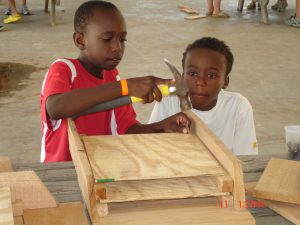
Building a bat house is a great activity for kids interested in wildlife. Photo credit: Carrie Stevenson, UF IFAS Extension
Human contact with bats is rare unless the bats are sick, which is why one found on the ground should be left alone. Rabies transmission from bats accounts for only one death per year in the United States—a statistic much less than that of deaths from dog bites, bee stings, and lighting strikes! In fact, several towns in Texas with the highest populations of bats in the country have recorded zero human bat-transmitted rabies cases.
Bat populations are declining in North America due to disease (particularly white-nose syndrome), loss of habitat, and the slow reproductive cycle of bats. However, you can help the world’s only flying mammal by installing a bat house in your yard. Keep in mind that bats attracted to bat houses prefer to be in open areas away from trees (where their predators hide), and the house should be installed at least 12 feet in the air. Bat houses can be purchased or built rather simply—this UF IFAS Extension publication outlines several types, or visit Bat Conservation International’s website for simple instructions.

by Carrie Stevenson | Sep 16, 2016
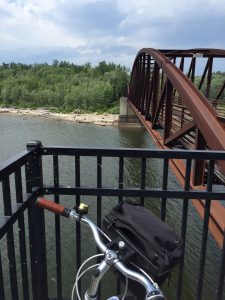
The bridge over the Winooski River was a scenic stop on our bicycle tour. Photo credit: Carrie Stevenson
If you told me earlier this summer that I would “accidentally” bike 18 miles one afternoon, I’d have laughed. I’ve always loved biking, but rarely have time for long distance rides. As part of the mobile workshops for an Extension professional development meeting in Burlington, Vermont, fifteen of us met up with the coordinator of Local Motion, a grassroots bike advocacy organization. Their mission is “to bring the joy of walking and biking within reach for all Vermonters by helping Vermont communities become great places to walk and bike.” The purpose of the tour was to get an on-the-ground lesson in community development and learn how the group has worked with residents to overcome challenges in implementing a successful project.
Burlington’s “Island Line Trail” is a classic rails-to-trails project–not unlike the Blackwater Heritage Trail in Santa Rosa County–that has resulted in significant economic development and increased use by area residents. The original rail service operated from 1899 to the early 1960’s. Since the 1990’s, 14 miles of railway has been converted to a biking/walking trail. Part of the Island Line’s charm is the diversity of scenery it encompasses.
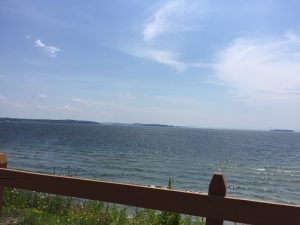
Sweeping views of Lake Champlain were part of what kept us riding far beyond our initial endpoint! Photo credit: Carrie Stevenson
Starting in the heart of downtown Burlington, there are museums, shops, and restaurants within blocks of the trail, many of which cater directly to and exist because of the trail users. The entire stretch runs adjacent to Lake Champlain, providing scenic views along the path. Throughout the trail there are residential areas (which are highly desired because of their proximity to the trail), public parks, and a community center. After crossing a bridge over the Winooski River, we embarked upon a 3-mile open causeway with sweeping views of Malletts Bay on both sides. The trail also includes one of the country’s few bike ferries, which is located where a swing bridge used to operate for the railway. It was the constantly changing scenery and surroundings that kept a handful of us going far beyond the initially planned 6-mile trip.
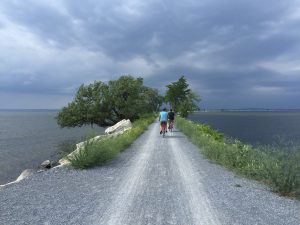
The causeway over Malletts Bay includes a bike ferry, one of the few in the country. Photo credit, Carrie Stevenson
In addition to providing a recreational trail for local residents and visitors, Local Motion is dedicated to promoting bicycle safety and education. Workshops for hesitant adult bikers interested in biking more attracted over 450 adults last year, while 7,300+ kids participated in bicycle safety camps and training. As a result of all of the activity, youth bike rentals increased by 43% in 2015 over the prior year.
Much of the success in Burlington is transferable to Florida. In the Panhandle, we are looking at connecting existing trails to create a large-scale multi-county, multi-state bicycle trail. The successes in Vermont were inspirational and instructional as we embark upon our new project and a design workshop in late September.

by Carrie Stevenson | Jun 17, 2016
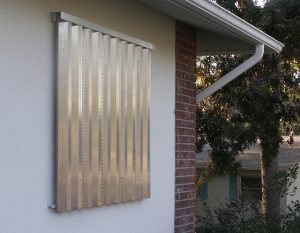
Aluminum shutters help protect windows from flying debris during windstorms.
Here in the latter half of June, temperatures have heated up and summer thunderstorms have swept through on a regular basis. As we are reminded often, hurricane season has begun. While we haven’t had a major storm in 11 years, northwest Florida is still a prime target.
Be Ready Florida is a statewide program dedicated to helping citizens and visitors to the state prepare their homes, businesses, and families for the onslaught of a major windstorm. In order to teach individuals how to best prepare, three free, two-hour online BRACE for the Storm workshops are scheduled for June 29. The workshops will be held from 10 am-noon, 2-4 pm, and 7-9 pm. Registration is online here.
According to their website, “During each workshop participants will gain valuable insight on how homeowners can undertake one or more windstorm mitigation projects on their homes to strengthen it against Florida’s next wind disaster. The importance of mitigating homes against the damage caused by a flood or wildfire will also introduced.” The workshops also discuss how mitigation techniques can save money on homeowner’s insurance.
Be Ready Florida also offers an online directory of contractors, suppliers, funding sources and inspectors that homeowners can access to find help with home projects. In Escambia and Santa Rosa County, homeowners can also contact Rebuild Northwest Florida, a nonprofit organization that uses FEMA funds to offset the cost of home wind mitigation.
To see examples of common wind mitigation building materials and techniques, such as storm shutters, insulated concrete forms, a wind-rated garage door and a tornado shelter, you can visit the Escambia County Extension office at 3740 Stefani Road in Cantonment. To schedule a tour or receive more information about the demonstrations found there, contact me at ctsteven@ufl.edu

by Carrie Stevenson | May 8, 2016
The beginning of hurricane season—June 1—is very nearly upon us. It’s been more than ten years since northwest Florida was on the receiving end of a destructive hurricane. However, we’ve been no strangers to devastating floods, tornadoes, and even an ice storm over the past few years. No matter what natural disaster lurks around the next corner, there are steps every single resident can take to reduce the impact storms have on your family and property.

Aluminum shutters are one of the many preventative measures panhandle homeowners can include in their hurricane preparedness.
Photo: Carrie Stevenson
The week of May 15-21 has been designated “Hurricane Preparedness Week,” and there will be lots of information in the media about the 2016 Atlantic hurricane season, including preparation checklists and mock hurricane drills. As part of the effort led by National Oceanic and Atmospheric Association (NOAA), we will be sending out daily reminders and tips over Extension social media outlets during Hurricane Preparedness Week to remind readers of practical tips for preparing.
The main thrust of the message is fivefold: Know your evacuation zone http://flash.org/hurricane-season/ ; have an insurance checkup http://www.flash.org/homeownersinsuranceguide/ ; build a disaster supply kit http://www.redcross.org/get-help/prepare-for-emergencies/be-red-cross-ready/get-a-kit ; strengthen your home http://www.rebuildnwf.org/ ; and help your neighbor http://www.fema.gov/community-emergency-response-teams .
In Escambia and Santa Rosa counties, residents can contact Rebuild Northwest Florida http://www.rebuildnwf.org/ to learn how to mitigate windstorm damage at a quarter of the actual cost. Community Emergency Response Team (CERT) training is available in many communities, which builds teams of neighborhood leaders to help with immediate response before professional emergency personnel can arrive.
It is easy to be complacent when we haven’t had a big hurricane in a while. However, it’s important—especially for newcomers to the area—to be educated about your options and make a plan in case it’s ever needed.
If you’re interested in learning more, check out NOAA’s information at http://www.nws.noaa.gov/com/weatherreadynation/hurricane_preparedness.html or the Federal Alliance for Safe Homes (FLASH) website http://hurricanestrong.org














